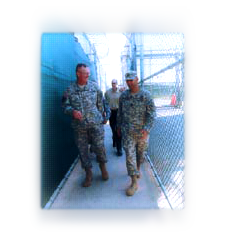|
|
 |
 |
DESTINATION GUANTANAMO BAY, CUBA
The Legitimacy of GTMO: An Eyewitness Report, Page 14
A Travel Journal by Dr. Eric A. Zillmer
Pacifico Professor of Psychology at Drexel University

< PREVIOUS SECTION | NEXT SECTION >
|
 |
 |
Briefing at Headquarters of the Joint Task Force
1130

|
 |
We transfer to a bus, which takes us east over a 300-foot ridge and divides the detention camps from the living quarters. We enter the security checkpoint for the detention camps and proceed to the headquarters of the Joint Task Force (JTF). The JTF is responsible for over 2,000 troops that administer the detention facilities and carry out the operational missions of the camps. In charge of the JTF is Admiral Harry Harris who will conduct our initial briefing.
There are approximately 430 detainees held at GTMO, “enemies of the nation,” the Admiral explains. It is underscored that these are not innocent bystanders, but are terrorist trainers, master bomb makers, would be-suicide bombers, Bin Laden bodyguards, among others. Some are very wealthy and are considered terrorist financiers.
One of the major missions of JTF, the Admiral states is as an intelligence resource in the fight against the Taliban and al Qaeda. It is thought that the information gleaned from detainees has intelligence capital, will assist in winning the war on terrorism, and prevent further terrorist attacks. A further mission of GTMO is to retain terrorists from returning to the battlefield, where most of them have been captured in the first place. There is an annual review board in place that meets to determine whether the detainees remain a risk to the U.S. Surprisingly we learned that hundreds of detainees have departed GTMO. These detainees were either transferred to other countries where they faced charges or returned to their country of origin and released, if they no longer were thought to present a security risk.
The Admiral assures us that all detainees are treated humanely and in accordance with U.S. law, the law of war, and applicable U.S. policy. We are shown bullets in a PowerPoint presentation that outline all required Geneva Convention rules. A detainee is defined as any person captured, detained, held, or otherwise under the control of DoD personnel, including enemy combatants who are individuals who engaged in hostilities against the U.S.
Prohibited in the treatment of detainees are humiliation and degrading treatment including torture. The sick shall be cared for. We are provided detailed DoD Directives on the Detainee Program and instructions on the Medical Program Support for Detainee Operations. Regarding the latter we are assured that medical records are safeguarded, including confidentiality within the constraint of the law, that is with the exception of a detainee’s threats to oneself or others.
NEXT...
|
|
|